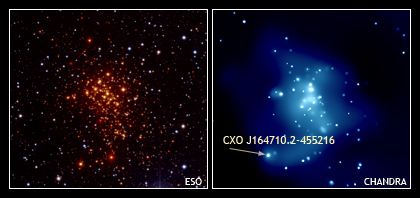November 02, 2005
RELEASE: 05-08
A very massive star collapsed to form a neutron star and not a black hole as expected, according to new results from NASA's Chandra X-ray Observatory. This discovery shows that nature has a harder time making black holes than previously thought.
Scientists found this neutron star -- a dense whirling ball of neutrons about 12 miles in diameter -- in an extremely young star cluster. Astronomers were able to use well-determined properties of other stars in the cluster to deduce that the progenitor of this neutron star was at least 40 times the mass of the Sun.
"Our discovery shows that some of the most massive stars do not collapse to form black holes as predicted, but instead form neutron stars," said Michael Muno, a UCLA postdoctoral Hubble Fellow and lead author of a paper to be published in The Astrophysical Journal Letters.
When very massive stars make neutron stars and not black holes, they will have a greater influence on the composition of future generations of stars. When the star collapses to form the neutron star, more than 95% of its mass, much of which is metal-rich material from its core, is returned to the space around it.
"This means that enormous amounts of heavy elements are put back into circulation and can form other stars and planets," said J. Simon Clark of the Open University in the United Kingdom.
Astronomers do not completely understand how massive a star must be to form a black hole rather than a neutron star. The most reliable method for estimating the mass of the progenitor star is to show that the neutron star or black hole is a member of a cluster of stars, all of which are close to the same age.
Because more massive stars evolve faster than less massive ones, the mass of a star can be estimated from if its evolutionary stage is known. Neutron stars and black holes are the end stages in the evolution of a star, so their progenitors must have been among the most massive stars in the cluster.
Muno and colleagues discovered a pulsing neutron star in a cluster of stars known as Westerlund 1. This cluster contains a hundred thousand or more stars in a region only 30 light years across, which suggests that all the stars were born in a single episode of star formation. Based on optical properties such as brightness and color some of the normal stars in the cluster are known to have masses of about 40 suns. Since the progenitor of the neutron star has already exploded as a supernova, its mass must have been more than 40 solar masses.
Introductory astronomy courses sometimes teach that stars with more than 25 solar masses become black holes -- a concept that until recently had no observational evidence to test it. However, some theories allow such massive stars to avoid becoming black holes. For example, theoretical calculations by Alexander Heger of the University of Chicago and colleagues indicate that extremely massive stars blow off mass so effectively during their lives that they leave neutron stars when they go supernovae. Assuming that the neutron star in Westerlund 1 is one of these, it raises the question of where the black holes observed in the Milky Way and other galaxies come from.
Other factors, such as the chemical composition of the star, how rapidly it is rotating, or the strength of its magnetic field might dictate whether a massive star leaves behind a neutron star or a black hole. The theory for stars of normal chemical composition leaves a small window of initial masses - between about 25 and somewhat less than 40 solar masses - for the formation of black holes from the evolution of single massive stars. The identification of additional neutron stars or the discovery of black holes in young star clusters should further constrain the masses and properties of neutron star and black hole progenitors.
The work described by Muno was based on two Chandra observations on May 22 and June 18, 2005. NASA's Marshall Space Flight Center, Huntsville, Ala., manages the Chandra program for the agency's Science Mission Directorate. The Smithsonian Astrophysical Observatory controls science and flight operations from the Chandra X-ray Center in Cambridge, Mass.
Additional information and images are available at:
MEDIA CONTACTS
Steve Roy
Marshall Space Flight Center, Huntsville, Ala.
(Phone: 256/544-6535)
Megan Watzke
Chandra X-ray Center, Cambridge, Mass.
(Phone: 617/496-7998)






